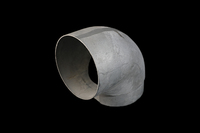Die Casting Supplier introduces the manufacturing strategy of a
-
As we all know, for steel with high carbon content, high hardness and low plasticity can be obtained immediately after quenching. However, for aluminum alloy die castings, the strength and hardness of the aluminum alloy die castings will not increase immediately after quenching, but the plasticity will not decrease, but increase. However, after a period of time, the strength and hardness of the quenched aluminum alloy die castings will be significantly improved, and the plasticity will be significantly reduced. The phenomenon that the strength and hardness of quenched aluminum alloy die castings increase significantly over time is called aging. Aging can occur at room temperature, which is called natural aging. It can also occur in a temperature range higher than room temperature, which is called artificial aging.Die Casting Supplier introduced that age hardening of aluminum alloy castings is a very complicated process. It depends not only on the composition and aging process of aluminum alloy castings, but also on the defects caused by aluminum alloy castings during the production process, especially the number and distribution of vacancies and dislocations. At present, it is generally believed that age hardening is the result of the polarization of solute atoms forming a hardened zone.
When aluminum alloy die castings are quenched and heated, vacancies are formed in the alloy. When quenched, due to rapid cooling, these vacancies are too late to be removed and are "fixed" in the crystal. Most of these vacancies in the supersaturated solid solution are combined with solute atoms. Since the supersaturated solid solution is in an unstable state, it will inevitably change to an equilibrium state, and the existence of vacancies accelerates the diffusion rate of solute atoms, thereby accelerating the segregation of solute atoms.
The size and quantity of the quenching zone of aluminum alloy die castings depends on the quenching temperature and quenching cooling rate. The higher the quenching temperature, the higher the vacancy concentration, the more the number of hardened zones and the smaller the size of the hardened zones. The greater the quenching cooling rate, the greater the vacancy in the solid solution, which is beneficial to increase the number of quenching zones and reduce the size of the quenching zone of aluminum alloy die castings. A basic feature of the precipitation hardening aluminum alloy die-casting system is that the equilibrium solid solubility changes with temperature, that is, the solid solubility increases with the increase of temperature. Most heat-treatable aluminum alloy pressure castings meet this condition.
Through the above introduction, Aluminum Die Casting Manufacturers hopes that you can simply refer to the content of this article in future use.

